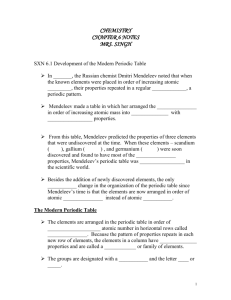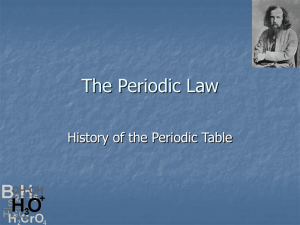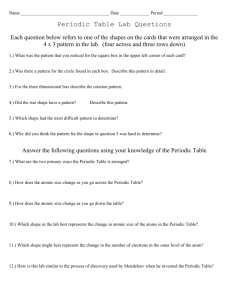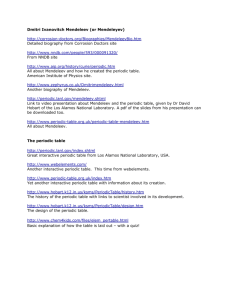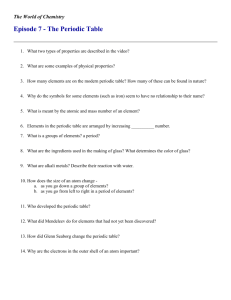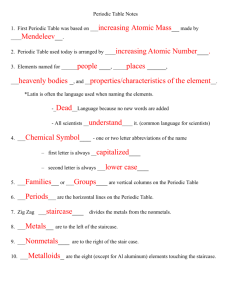Linnaeus, Mendeleev, Dewey, & Ranganathan
advertisement
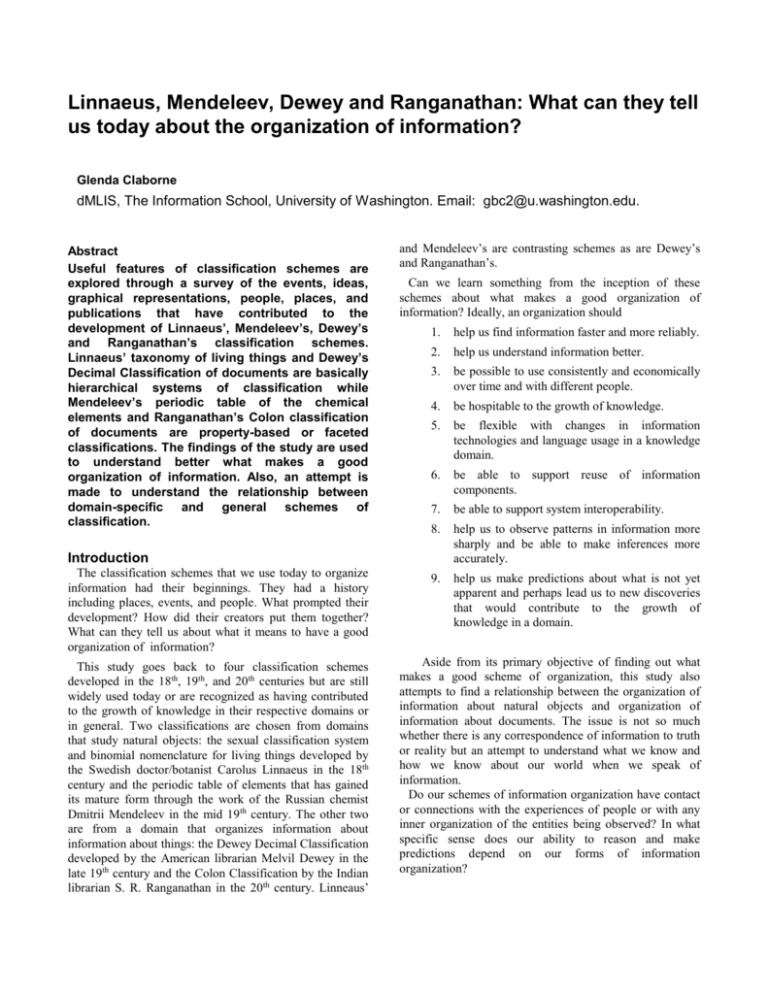
Linnaeus, Mendeleev, Dewey and Ranganathan: What can they tell us today about the organization of information? Glenda Claborne dMLIS, The Information School, University of Washington. Email: gbc2@u.washington.edu. Abstract Useful features of classification schemes are explored through a survey of the events, ideas, graphical representations, people, places, and publications that have contributed to the development of Linnaeus’, Mendeleev’s, Dewey’s and Ranganathan’s classification schemes. Linnaeus’ taxonomy of living things and Dewey’s Decimal Classification of documents are basically hierarchical systems of classification while Mendeleev’s periodic table of the chemical elements and Ranganathan’s Colon classification of documents are property-based or faceted classifications. The findings of the study are used to understand better what makes a good organization of information. Also, an attempt is made to understand the relationship between domain-specific and general schemes of classification. and Mendeleev’s are contrasting schemes as are Dewey’s and Ranganathan’s. Can we learn something from the inception of these schemes about what makes a good organization of information? Ideally, an organization should 1. help us find information faster and more reliably. 2. help us understand information better. 3. be possible to use consistently and economically over time and with different people. 4. be hospitable to the growth of knowledge. 5. be flexible with changes in information technologies and language usage in a knowledge domain. 6. be able to support reuse of information components. 7. be able to support system interoperability. 8. help us to observe patterns in information more sharply and be able to make inferences more accurately. 9. help us make predictions about what is not yet apparent and perhaps lead us to new discoveries that would contribute to the growth of knowledge in a domain. Introduction The classification schemes that we use today to organize information had their beginnings. They had a history including places, events, and people. What prompted their development? How did their creators put them together? What can they tell us about what it means to have a good organization of information? This study goes back to four classification schemes developed in the 18th, 19th, and 20th centuries but are still widely used today or are recognized as having contributed to the growth of knowledge in their respective domains or in general. Two classifications are chosen from domains that study natural objects: the sexual classification system and binomial nomenclature for living things developed by the Swedish doctor/botanist Carolus Linnaeus in the 18th century and the periodic table of elements that has gained its mature form through the work of the Russian chemist Dmitrii Mendeleev in the mid 19th century. The other two are from a domain that organizes information about information about things: the Dewey Decimal Classification developed by the American librarian Melvil Dewey in the late 19th century and the Colon Classification by the Indian librarian S. R. Ranganathan in the 20th century. Linneaus’ Aside from its primary objective of finding out what makes a good scheme of organization, this study also attempts to find a relationship between the organization of information about natural objects and organization of information about documents. The issue is not so much whether there is any correspondence of information to truth or reality but an attempt to understand what we know and how we know about our world when we speak of information. Do our schemes of information organization have contact or connections with the experiences of people or with any inner organization of the entities being observed? In what specific sense does our ability to reason and make predictions depend on our forms of information organization? Linnaeus’ classification of living things (Carl Linnaeus 1707-1778) Sexual System of Classification In his Systema Naturae, a 12-page manuscript published in 1735, Linnaeus laid out a system of classification for each of the “three kingdoms of nature” (the mineral, vegetable, and animal kingdoms). For each kingdom, he listed a number of observations and then arranged his classification in a table. But among the three, it was his sexual system of classification for plants that was most original, in the sense that he was the first to systematically use the reproductive features of plants in botanical classification. The Greeks had not considered sexual reproduction among plants but it was already widely discussed during Linnaeus’ time. Linnaeus considered it a common-sense idea and mentioned several people who have already studied the topic before him: “That anthers and stigmas constitute the sex in plants, has been discovered, described and assumed as infallible by Grew, Ray, Camerarius, Morland, Vaillant, Blair, de Jussieu, Bradley, van Royen, etc.; nor can anybody who examines the flowers of whichever plant with open eyes fail to see it.” For Linnaeus, observations on how living beings are reproduced formed the foundation for his systems of classification for plants and animals. “The essence of plants,” wrote Linnaeus, “consists in the fructification.” “Each fruit is preceded by a flower; the essence of the flower consists in anthers and stigma.” Figure 1: Parts of a Flower (Source: http://images.encarta.msn.com) Linnaeus described the essence of plants in terms of the reproductive parts of flowers but he used these structural parts only in so far as they helped in organizing the wide variety of sexual behavior among plants. His classification is as much based on social contexts as on the structural features of the objects he was trying to organize. We can see the social context in which Linnaeus systematized a classification of sexual behaviors among plants in an earlier publication, Praeludia Sponsalarium Plantarum, a thesis he wrote to present his views on a disputation of a dissertation concerning the nuptials of trees when he was a student at Uppsala University. The thesis opens with the following poetic excerpt (not unusual for academic publications in Linnaeus time): “In spring, when the bright sun comes nearer to our zenith, he awakens in all bodies the life that has lain stifled during the chill winter…’ “Words cannot express the joy that the sun brings to all living things…Yes, Love comes even to the plants. Males and females, even the hermaphrodites, hold their nuptials…” “The actual petals of a flower contribute nothing to generation, serving only as the bridal bed which the great Creator has so gloriously prepared, adorned with such precious bedcurtains, and perfumed with so many sweet scents in order that the bridegroom and bride may therein celebrate their nuptials with the greater solemnity…” Plants have sexual or nuptial relations. So we see in Linnaeus’ 24 classes of plants that the nuptials can be either “publicae” (stamens and pistils nude and visible) or “clandestinae” (covered and hidden in membrane). The “publicae” can be further subdivided into Monoclinia (hermaphrodites – stamens and pistils in one flower) or Diclinia (stamens and pistils in separate flowers). The Monoclinias can be further distinguished according to the number of stamens – Monandria (one), Diandra (two), Triandria (three), etc. Among the Diclinias, there may be pure marriages (stamens and pistils are in separate flowers – Monoecia on the same plant, Dioecia on separate plants) or there may be adulterous (Mechea, Moechia) or polygamous (Polygamia) marriages. Linnaeus went on further to subdivide the 24 classes into 65 orders, this time based on the number and position of the pistils. [Note here that instead of using the structural terms stamens and pistils, Linnaeus used the Greek for husband (andria) and wife (gynia). (a) (b) Figure 2: (a) Graphic representation of Linnaeus’ sexual system of classification. (b) One of Linneaus’ tables (only half of the folio format is showing). This one is for the vegetable kingdom. He also drew tables for the mineral and animal kingdoms. (Linneaus, 1735, Systema Naturae) The sexual imagery in Linnaeus’ new method scandalized the straitlaced in society and was not welcomed by other botanists as in this excerpt from a letter to Linnaeus from a botanist named Dillenius: “I consider sexual differences altogether useless, superfluous, even misleading, for establishing the character of a plant. What is the point of it all? It is puerile…” (Blunt 2001, p. 119). But for many, the new system has proven very useful and practical. Johan Grovonius, a doctor and botanist whom Linnaeus met while he was living in Amsterdam and who has helped him publish the Systema Naturae has this to say about Linnaeus new method: “Sometimes we examined minerals, sometimes flowers and plants, insects or fishes. We made such progress that by [Linnaeus’s] Tables, [his Systema Naturae] we can now refer any fish, plant, or mineral to its genus, and thus to its species, though none of us had seen it before. I think these Tables so eminently useful that everyone ought to have them hanging up in his study, like maps. Boerhave values this work highly and it is his daily recreation” (Blunt 2001, p. 124). Linnaeus’ tables (see Fig. 2b) provided a simpler and more practical tool for classification to more people, which included amateur botanists, gardeners, and travelers than other systems then in use. The botanical system then generally in use was by the famous 17th century French botanist, Joseph Pitton Tournefort. He also based his classification on the structure of the flower and the fruit but denied the sexuality of plants. Tournefort maintained the old division of plants into herbs, trees, and shrubs. He also emphasized classification on genera and he believed that people should be able to memorize the 698 natural genera encompassing the 10,000 species then known (Farber, 2001). Although Linnaeus was confident that his new system was a great improvement on older systems, he never claimed that it was altogether a natural system of classification. He wrote: “No natural system of plants, though one or the other approaches it quite closely, has so far been constructed; nor do I contend that this system is really natural (perhaps some other time I may issue fragments of one); nor can it become a natural system before all details in connection with our system will be known. In the meantime, however, as long as a natural system is lacking, artificial systems will definitely be needed.” (Linnaeus 1735, p. 23). We must note here that the terms ‘natural’ and ‘artificial’ systems have more to do with the number of characteristics chosen to divide a collection into groups rather than the nature of those characteristics themselves. Linneaus “recognized that organisms could be classified into major groups by two main methods, one using the natural characters, i.e. a large number of characters in association and one using only artificial characters, i.e. a few selected for convenience in dividing a mass of objects somehow into groups” (Stearn, 2001, p. 246). Binomial Nomenclature Along with a systematic and methodical system of classifying things in nature, Linnaeus also placed great importance on name-giving. Linnaeus has done a lot of work in other areas of biology but his introduction of a binomial nomenclature for plants and animals is considered to be his most useful contribution to the field. By international agreement among botanists, Linnaeus’ works are the starting-points for nomenclature in biology: the Species Plantarum (1753), together with his Genera Plantarum (5th ed., 1754) for naming plants and the Systema Naturae, vol. 1 (10th ed., 1758) for naming animals (Stearn, 2001). Based on the starting point for botanical nomenclature, all botanical names before 1753 are not accepted into modern nomenclature, including the ones coined by Linnaeus himself before he published Species Plantarum. The two-word naming of plants and animals using one word to refer to a general grouping (genus) and the other to refer to the specific (species) has had a long tradition of use before Linnaeus. Linnaeus, however, was the first to champion uniform use in naming plants and animals. Stearn (2001) notes that Linnaeus coined Latin or internationally usable Latin forms of names for about 4, 400 species of animals and 7, 700 species of plants and has linked these names with descriptions, diagnoses, and illustrations which stabilized their use. Mendeleev’s periodic table of elements Dmitri Mendeleev 1834 –1907 Mendeleev was a 35-year old professor of chemistry at St. Petersburg University in 1869 when he drafted the tabular classification of elements that would lead him to discover the periodic law of chemical elements. He drafted the table as part of his effort to write the second volume of a twovolume textbook, Principles of Chemistry, for his students. New chemical elements were being discovered – 70 known elements identified by their atomic weights at that time. This growing number of elements presented new challenges in how to classify and organize them and Mendeleev took on the challenge. Gordin (2004, p.43) emphasizes that “Mendeleev was not concerned in 1869 with establishing a basic law of chemistry. He was concerned with writing a textbook for young chemists at St. Petersburg University.” But Morris (2003) writes that Mendeleev had long been concerned that “chemistry had no guiding principle” and this has motivated him to find some order or pattern somewhere. Mendeleev’s initial grouping of the elements by similarity of their properties in the first volume was not ordered in any sequence and he tried to address this in the second volume. Morris (2003) describes the process by which Mendeleev organized the elements. Mendeleev first made up cards for each of the 63 elements on which he wrote the atomic weight of the element and its most important chemical and physical properties. Atomic weight at that time was determined by carefully measuring the proportions, by weight, of the elements forming a compound (as contrasted with the routine use of mass spectrography today). Mendeleev asked several chemists all over Europe to send him the atomic weights that they had obtained. He wrote the figures on his cards as they arrived and he did his own chemical experiments to verify the figures. He then arranged the cards in order of increasing atomic weight, beginning with hydrogen, the lightest, and ending with uranium, the heaviest at that time. “Then he pored over the cards for days, looking for patterns. Finally, he pinned the cards on the wall, putting similar elements in horizontal rows. He looked at the table that this formed, made changes, and pinned the cards on the wall again” (Morris, 2003, p. 165). Through this process of pinning cards in horizontal rows by increasing atomic weight, Mendeleev observed the same kinds of properties after every seven elements. This pattern had been previously observed by John Newlands (of England) six years earlier though he did not show a complete table. Newlands grouped elements with analogous properties and observed that many pairs of elements with analogous properties differed in atomic weight by 8 or 16 units. He called this the Law of Octaves. Before Newlands, Johann Dobereiner, a professor of chemistry in Germany, discovered a Law of Triads in 1817. Dobereiner has observed that the middle member of a triad has the mean weight of the two flanking members. Scerri (2001) notes however that Dobereiner’s triads did not concern elements but instead their compounds. Van Spronsen (1969, p. 134) describes Mendeleev’s method of arriving at the periodic system as “something (a) (b) Figure. 3. (a) A draft of Mendeleev’s periodic system dated 17 Feb 1869. (b) The first published form of Mendeleev’s periodic system. Notice the gaps with question marks for elements that Mendeleev suspected existed. One has to rotate the table by 90 degrees clockwise to see the resemblance to the horizontal rows and vertical columns that we are familiar with today. (Source: Gordin, 2004. Red circling mine.) like solving a puzzle.” Mendeleev continued puzzling by making sketches on paper (see Fig. 3a for an example of Mendeleev’s early sketches). We can see here that Mendeleev adopted the plane tabular representation with vertical periods, a representation also favored by his contemporaries. But in comparing Mendeleev’s system (see Fig. 3b) with the systems of many scientists who also attempted to represent the analogies between elements, particularly that of Lothar Meyer’s, Mendeleev’s rival for the honor of discovering the periodic system, Van Spronsen (1969, p. 134) shows that Mendeleev’s system “encompasses almost all the facets of a true periodic system of elements and should therefore be seen as the culmination of the period of discovery.” Van Spronsen especially mentions the following aspects of Mendeleev’s system: 1. the division into main and subgroups 2. the vacant spaces left for undiscovered elements together with the prediction of some of their properties, i.e., the homologues of aluminum and silicon 3. the classification of the transition metals 4. the reversal of tellurium-iodine. Van Spronsen (1969, p.135) comments that “Mendeleev’s work was so brilliant precisely because he knew nothing of the studies of his contemporaries, which had been published on the same subject since 1862.” Mendeleev has studied in France and Germany on a grant from the Russian government from 1859-1860 (Morris, 2003). During that time, he was able to attend a very important congress of chemists at Karlsruhe in 1860 where he heard Cannizzaro speak on a solution to the confusions surrounding the concept of atomic weight. Lothar Meyer also attended the congress. Newlands was not able to. Mendeleev probably made some important acquaintances, especially those he asked for figures of atomic weights later, but scientific communications and publications were still difficult at that time and Russia was considered backward compared to the other countries in Europe. Confident of the validity of the periodic law and his predictions of the existence of unknown elements, Mendeleev would later scour international scientific literature to see if his predictions were confirmed (Gordin, 2004). Indeed, the first of these would occur in 1875 when eka-aluminum (named Gallium) was discovered in France. This drew attention to Mendeleev’s periodic system. The scientific world would be more astonished at the predictive powers of Mendeleev’s periodic system when eka-boron (scandium) and eka-silicon (germanium) were discovered in 1879 in Sweden and 1886 in Germany, respectively. The Graphic Representation of the Periodic System That Mendeleev abstracted periodicity out of the context presented by sketches of an arrangement of the chemical elements points to the major role that graphic representation played in the discovery of the periodic law. Mendeleev was confident in his predictions of new elements and in his corrections of wrong atomic weights but he was hesitant about the best way to represent the periodic law. He was very sure of the simplicity of the periodic law but struggled with an adequate representation of the complexity of the relationships between the elements. Mendeleev stated the periodic law as follows: “The properties of the elements as well as the forms and properties of their compounds are in a periodic dependence or, expressing ourselves algebraically, form a periodic function of the atomic weight of the elements” (Mendeleev, 1891, p. 16, quoted in Bensaude-Vincent, 2001, p. 134). Bensaude-Vincent (2001, p. 134) writes that the use of the term ‘function’ instead of the more neutral term ‘dependence’ “emphasized the quantitative treatment of analogies: the atomic weight of the elements, being a common and measurable property, allowed systematic and accurate comparisons of the individual elements.” She suggests that Mendeleev could have expressed his function by means of a curve – the elements arranged along the axis of an abscissa according to their atomic weights and the value of one of one of their chemical or physical properties on the vertical axis. This solution was used by Meyer, but was rejected by Mendeleev for the following reasons: “The method, although graphic, has the theoretical disadvantage that it does not in anyway indicate the existence of a limited number of elements in each period. There is nothing for instance in this method of expressing the law of periodicity to show that between magnesium and aluminum there can be no other element with an atomic weight of say 25, atomic volume 13, and in general having properties between those of these two elements. The actual periodic law does not correspond with a continuous change of properties, with a continuous variation of atomic weight – in a word, it does not express an uninterrupted function – and as the law is purely chemical, starting from the conceptions of atoms and molecules which combine in multiple proportions, with intervals (not continuously) it, above all, depends on there being but a few types of compounds which are arithmetically simple, repeats themselves, and offered no uninterrupted transitions, and therefore each period can only contain a definite number of members” (Mendeleev, 1891, p. 19, quoted in BensaudeVincent, 2001, p. 135). Mendeleev was probably aware of the difficulty of having to draw a curve for each of the properties covered by the periodic law if he had chosen to express his function by means of a graphic curve. His priority seemed to be to show the discontinuity of chemical phenomena based on the two fundamental laws of definite and multiple combinations. Bensaude-Vincent (2001) points out that Mendeleev’s emphasis on the discontinuity of chemical phenomena is linked to his definition of the object of his classification – elements as opposed to simple substances. Mendeleev (1879) stressed this distinction in the following statement: “Even as, up to Laurent and Gerhardt, the words ‘molecule’, ‘atom’, and ‘equivalent’, were used one for the other indiscriminately in the same manner, so now the terms ‘simple body’ and ‘element’ are often confounded one with the other. They have however, each a distinct meaning, which is necessary to point out, so as to prevent confusion of terms in philosophical chemistry. A ‘simple body’ is something material, metal or metalloid, endowed with physical properties and capable of chemical reactions. The idea of molecule corresponds with the expression of a simple body (…) But in opposition to this, the name of ‘element’ must be reserved for characterizing the material particles which form simple and compound bodies, and which determine their behavior from a chemical and physical point of views. The word ‘element’ calls to the mind the idea of an atom; carbon is an element; coal, diamond and graphite are simple bodies.” (p. 243) We have to understand here that even though Mendeleev connected the word ‘element’ to the idea of an atom, he did not take the structure of atoms as his starting point. He emphasized that the most important aspect of the periodic system was the existence of a periodic law, not of atoms as discrete physical bodies, much less that atoms might have substructures. According to Bensaude-Vincent, Mendeleev was trying to identify the cause of the discontinuity of chemical combinations and that he identified it to be the elements. In Mendeleev’s classification system, elements are true individuals identified by a numerical property, their atomic weight. The periodic law, Mendeleev (1891) wrote, “expresses the properties of the real elements, and not of what may be termed their manifestations visually known to us. The external properties of the elements and compounds are in periodic dependence on the atomic weight of the elements only because these external properties are themselves the result of the properties of the real elements forming the isolated elements or the compound. “ Mendeleev favored the table because it seemed to be the best format that could represent the discontinuity of chemical phenomena but he was also aware that he was breaking the sequence of the elements from hydrogen to uranium. “In reality,” wrote Mendeleev (1879, p. 291), “the sequence of elements is uninterrupted and to a certain extent represents a spiral function.” He did draw several spiral systems to express the periodic law. He even considered a cubical system (van Spronsen, 1969). But ‘he stuck to the compact form of the table based on short series never exceeding eight members” (Bensaude-Vincent, 2001, p. 141) (a) (b) Figure 4: A few examples of the hundreds of ways to represent the periodic law of the elements. (a) Spiral similar to a triple lemniscate by Charles Janet, 1928. (b) Helix with four sizes of revolutions on four separate axes by Paul Giguere, 1966. (Source: Mazurs, 1974) Mendeleev’s tabular arrangement is only one of the hundreds of ways to arrange the chemical elements. There are so many that a classification of these arrangements themselves has been done by Mazurs (1957, 1974). Mazurs surveyed and analyzed approximately 700 periodic tables that were drawn up between 1871 and 1971, reduced the number to 146 different forms of periodic charts then classified these into types, classes, and then divisions based on the length of the periods in the tables. Mazurs also classified the tables according to their dimensional graphic representation – there are helical, spiral, cylindrical, and conic graphic representations of the periodic table of elements. For Mazurs (1974, p. xi), this diversity represents “the ability of the human mind to give disparate forms to the same body of matter.” For Bensaude-Vincent (2001), this great diversity in the visual representation of the periodic law is a striking contrast to the stability of the long rectangular matrix that we now regard as an icon of the order of nature. Bensaude-Vincent notes the irony that the long rectangular matrix as we are now very familiar with was the only form Mendeleev definitely abandoned in his attempts to adequately express the periodic law. The short periods that Mendeleev preferred are more suitable for teaching the behavior of and relationships between chemicals. The long form we now are used today seems to be a stable compromise between the use of the periodic table as a teaching tool and as a map to the inner structures of the atoms of chemical elements. Pamphlets of a Library. The manuscript consisted of only 44 pages with a preface written in the third person. It then lists the 10 main classes (9 “special libraries” plus a Generalities class) which are then further subdivided decimally into divisions and subdivisions. The manuscript also includes an alphabetical subject index with the Class Number/s next to each subject. The Class Number is to be used as a locator for resources under the corresponding subject either in the Subject Catalogue, Shelf Catalogue, or on the shelves. Dewey Decimal Classification Dewey was in his early 20s and was working as Assistant Librarian at Amherst College when he devised his system. Dewey’s early readings that helped him structure his work with libraries include: Melvil Dewey 1851-1931 Melvil Dewey published the first edition of his system anonymously in 1876. He titled it “A Classification and Subject Index for Cataloging and Arranging the Books and Dewey (1876) acknowledges that “theoretically, the division of every subject into just nine heads is absurd.” In the preface, he explains that “philosophical theory and accuracy have been made to yield to practical usefulness. The impossibility of making a satisfactory classification of all knowledge as preserved in books, has been appreciated from the first, and nothing of the kind attempted. Theoretical harmony and exactness has been repeatedly sacrificed to the practical requirements of the library or to the convenience of the department in the college.” Theory notwithstanding, it is perhaps the very simplicity and practicality of the Dewey Decimal system which makes it the world’s most widely used general library classification today. It is now in its 22nd edition and it is available both in print and electronic versions. It also has an abridged version, in print and electronic formats, tailored for smaller collections. - Edward Edwards’ “Memoirs of Libraries.” - Charles C Jewett’s “A Plan for Stereotyping Titles.” - William Torrey Harris’ article on book classification which appeared in the Journal of Speculative Philosophy. - Nathaniel Shurtleff’s pamphlet entitled “A Decimal System for the Arrangement and Administration of Libraries” privately printed in 1856. Dewey makes special mention of the Nuovo Sistema di Catalogo Bibliografico Generale of Natale Battezzati, of Milan, as perhaps his “most fruitful source of ideas.” But according to Wiegand (1996, p. ), it was probably Shurtleff’s pamphlet which gave Dewey his Eureka moment – “use decimals to number a classification of all human knowledge in print” and “marry the decimal system to library administration and arrangement.” The Dewey Decimal Classification (DDC) is a generalpurpose classification system and for that, the division and subdivision of knowledge beginning with ten main classes seemed to have served the purpose well. It is also worth noting some features of the scheme that has made it useful to many libraries. Ranganathan’s faceted classification (Shiyali Ramamrita Ranganathan 1892-1972) Ranganathan started his work on faceted classification in 1924 while he was in England for observational studies at the School of Librarianship at London. He was there as the first librarian of the University of Madras. He taught mathematics before accepting the librarianship. He has toured more than a hundred libraries in the United Kingdom and has observed that most of these libraries used the Dewey Decimal Classification. He found DDC rigid and tried to find a better way to classify documents. On his account, Ranganathan (1967, p. 106) describes the event that inspired him to develop a faceted classification. “I could not then say that what was needed was a faceted classification. But something was engaging my thought continuously. While in that condition, I happened to see a Meccano set in one of the Selfridges Stores in London. That gave me the clue. It made me feel that the class number of a subject should really be got by assembling ‘Facet Numbers’ found in several distinctive schedules, even as a toy is made by assembling an assortment of parts.” Mnenomics Dewey recognized the recurrence of certain subjects within and across the main classes and divisions so he used mnemonics to help users “in determining the character of any book simply from its call number as recorded on the book, on all its catalogue and cross reference cards, on the ledger, and in the check box.” So in DDC, we find hundreds of these numerical mnemonics as in 1 for China (931 in Ancient History, 951 in Modern History, under Asia, 491 in Languages, Chinese, etc). Chan, 1994, notes that this feature in DDC shows its considerable analyticsynthetic capabilities. Relative Index/Relative Location That books can be arranged in relation to other books instead of a definite location on shelves is not often recognized as an innovation and we take it for granted that it is plainly commonsense to arrange it that way. But before Dewey introduced relative location, books in many libraries had absolute locations, that is, the class number used then were also used as the location number and the shelf number. For example, a class number like 513-11 signified the 11th book on shelf 513 or alcove 5, range 1, shelf 3. Dewey did away with all this by disassociating the class number from a shelf number. Figure 5: A Meccano set. Not unlike Lego sets. To Ranganathan, the parts or components define facets. He defines a facet as “a generic term used to denote any component – be it a basic subject or an isolate – of a Compound Subject, and also its respective ranked forms, terms, and numbers” (Ranganathan, 1967, p. 88). So according to him, we may speak of Basic Facet, Isolate Facet, Language Facet, Property Facet, Author Facet, etc. Assembling these facets involves analyzing a document into a series of transformations from an ‘expressive title’ to a class number for a subject. This class number is made up of two or three ordinal numbers which, when taken together, fixes the position of the document relative to others. This process is to fulfill what Ranganathan calls the Five Laws of Library Science: 1. Books are for use 2. Every reader his book 3. Every book its reader 4. Save the time of the reader (and its corollary – Save the time of the staff) 5. Library is a growing organism. However, Ranganathan (1967, p.) admits that “millions and millions of isolate ideas, facets, and subjects confuse and taunt us at the phenomenal level…We must escape from this situation. A suitable method of escape would be to descend from the phenomenal level nearer and nearer to the seminal level.” This seminal level to Ranganathan is best represented by five fundamental categories as follows, in increasing difficulty of identification: 1. Time – “in accordance with what we commonly understand by that term.” Millenium, century, decade, year, and so on are its manifestations. 2. Space – as with time, in accordance with its usual significance. “The surface of the earth, the space inside it, and the space outside it” are manifestations of space. 3. Energy – ‘its manifestation is action of one kind or another. The action may be among and by all kinds of entities – inanimate, animate, conceptual, intellectual, and intuitive.” 4. Matter – its manifestations are of two kinds – Material, which is what an entity is made of, e.g. steel, timber, or Property, e.g. being 2 feet wide and 8 ft long. Both are intrinsic to the entity but are not the entity itself. 5. Personality – Ranganathan regarded this category as the most difficult to identify. “It is too elusive. It is ineffable.” The process of identifying it is a Method of Residues – “if a certain manifestation is easily determined not to be one of Time, Space, Energy, or Matter, it is taken to be the manifestation of the fundamental category, Personality.” The above 5 categories are best represented with the acronym PMEST – in decreasing concreteness. Although the category Personality is the most concrete, it is also the most difficult to identify as noted above. The Five Laws of Library Science and the Five Fundamental Categories sound simple but the formulations of Ranganathan’s theory of faceted classification are replete with terms, laws, canons, postulates, principles and devices which he explained with several references to fundamental texts in Hinduism. To many classification researchers in the West, these are esoteric concepts (cite references). For example, LaBarre (2004) quotes Phyllis Richmond, considered one of the experts in faceted classification in the US, as not “able to make head or tail of the great volumes of stuff that comes from the Ranganathan school.” However, these same people have agreed that new approaches to classification of knowledge that are more hospitable to the burgeoning increase in information were badly needed and have credited Ranganathan for pioneering faceted classification in the organization of information. Furthermore, Ranganathan’s Colon Classification, although not used outside of India and used in a few libraries in India itself, “provided an experimental test-bed” (Mills, 2004) for the development of faceted classification. Ranganathan’s Colon Classification was considered not useful for general classification schemes (Mills, 2004) but many found it useful for special collections and purposes. The Classification Research Group (CRG) in the UK has borrowed some of Ranganathan’s ideas in their work on constructing special classification schemes to correct the shortcomings and limitations of general classifications schemes such as the Dewey Decimal and the Library of Congress classification schemes. Prieto-Diaz (1991) considered Ranganathan’s faceted approach to library classification very helpful in the design of a reusable software component library for the GTE Data Services Asset Management Program and for the steps taken at the Contel Technology Center for furthering reuse technology. Kwasnik (1992) notes how Ranganathan’s ideas were used to classify computer software for re-use, patents, books, and art objects based on selected properties of these objects. Starr (1998) compares Ranganathan’s faceted classification with Glaser’s and Strauss’ grounded theory as used in sociology and anthropology to make sense of how disparate and diverse viewpoints are integrated in a representational system. Svenonius (1992) credits Ranganathan for giving some credibility to the “science” in library science. Discussion What does it mean to have a good organization of information? We have mentioned at the start that it should provide us with speed and reliability of access to information, consistency and economy of use over time with different people, and a better understanding of information, etc. What features of the classification schemes we have examined give us these advantages? It appears that schemes that could provide a map of the positions of entities relative to each other allow for the most speed and reliability of access. With Linneaus’ sexual classification of plants, the map came in the form of tables showing the genera and species of plants according to the number and location of their sexual parts. These tables of genera and species were further embedded in the higher taxons in Linnaeus taxonomy – family, order, class, kingdom. Users can follow the tables and identify plants that are males, females, or hermaphrodites and can follow the families and orders to which they belong by going up the taxonomic hierarchy. In Mendeleev’s periodic table (1869), the table shows an ascending order of elements according to their atomic weight with elements falling in vertical periods (horizontal later) with gaps left for unknown elements suspected to exhibit the properties of an element in that position relative to others in the table. The user looking at these tables can readily see a series and groupings of elements showing similar properties as well as the gaps where elements should be. The map formed in Dewey’s system is hierarchical in format like in Linnaeus taxonomy. But unlike a biological taxonomy with its implications of inheritance and evolutionary origins, a hierarchical organization of classes and divisions of the subjects of books can only imply broader and narrower relationships (with devices that point to horizontal or associative relationships). The hierarchy in Dewey’s system is formed by the assignment of a decimal system of notation that can expand or contract according to the specificity or generality of a subject. Users of a hierarchical system can go up or down these relationships to locate a general or specific subject or follow See or See also pointers to related subjects. The notations formed through faceted classification in Ranganathan’s system should also tell the user the specificity or generality of a subject and its position in a grouping of related subjects but unlike the periodic table of elements, the patterns and relationships in Ranganathan’s system were not made explicit through a table or an easily visualizable notational system. We should note here that the arrangement of objects or entities in a sequence that a user can easily follow depend on a numerical relationship between them. With the organization of natural objects as in Linnaeus’ and Mendeleev’s systems, this relationship comes from a quantifiable characteristic or property of the objects themselves – number of stamens and pistils and atomic weight respectively. It must be pointed however that these quantifiable properties are not self-evident. Although we may think flowers are plain to see, it took careful observations and comparisons by Linnaeus to choose the number of stamens and pistils as his basis of classification of plants. Atomic weights were not definite numbers that can be easily determined. Chemists made estimates through careful and precise quantitative analysis of as many compounds of an element as possible. Many times, they had to make adjustments to their measurements when these did not fit with other measurements. Even with modern spectrography, the measurement of atomic mass has to take into consideration that elements do not exist in nature having absolute mass. Many elements have isotopes. It is important to point out also the property initially used to arrange the elements in order (atomic weight) was later found out inadequate to account for some regularities in the properties of some elements. Henry Moseley determined in 1913 that the atomic number of the atoms of the elements is more reliable than atomic weight in arranging the elements in order and has been used ever since in arranging the periodic table. The notational systems in the DDC and Colon Classification are not based on quantifiable properties of the objects that they organize. They are ordinal numbers or symbols used to bring together groupings of subjects and to arrange documents in a meaningful sequence. One could argue however that if subjects are inherent properties of documents, then the process of transforming them into notations should make notations carriers of inherent properties of documents. Such seemed to be the confidence that drove Ranganathan to focus on notation as the expression of work done in his planes of ideas and terms. But it seems that in practice, the process does not always start with the ideas or subjects in a document. Ranganathan struggled with this but the flaw in the process can best be expressed by a critique made by Patrick Wilson. Wilson (1967) was very skeptical that the subjects of documents can readily be determined and he noted this indeterminacy in Ranganathan’s examples in teaching the Colon Classification. Wilson writes, “S. R. Ranganathan’s discussions of what he calls “canalization” might be expected to furnish the required instructions [about how one goes about identifying the subjects of a writing]; but in fact they do not do so. Rather, they guide the classifier towards a particular sort of verbal formulation of a statement of the subject of a writing, one so corresponding to the structure of the classification system that “translation” of the verbal formulation into the “language of ordinal numbers” becomes mechanical. … the examples given are always of translating a verbal formulation into the classificatory language, never of discovering what the book is about.” (1967, p. 73, footnote 9). While one may quibble with Wilson on this and go on and on about subjects and documents, the question of whether it is desirable for classification schemes to aim for depth of content in its representations must be raised. Would Linnaeus’ system have been more useful if it explicitly made references to genes and phylogeny? Would Mendeleev’s periodic table of elements have been more useful if it explicitly made references to electrons and quantum theory? Similarly, would it make the DDC more useful to incorporate into its scheme the capacity to classify precisely the minutest idea or subject in a document as Ranganathan aimed to do? Or is there a an optimal level of representation and organization where a classification scheme can best serve as a practical guide to the properties, relations, and locations of entities as experienced in everyday life while at the same time serve as powerful heuristics to deeper structures, content, and relations as needed for higher abstractions about our world? Conclusion Among the four classification schemes that have been surveyed in this study, Mendeleev’s periodic table of elements stands out as meeting most of the criteria that we listed as to what makes a good organization of information. Aside from the usual information retrieval criteria of ease of use, speed and reliability and the administrative criteria of economy and consistency of use over time and with different people, the periodic table has made it possible to see gaps in a sequenced order which led to discoveries that would transform the domain of chemistry and later physics. What property or properties of information can we use to organize information objects that will reveal gaps about our knowledge of a specific domain and which can lead us to discoveries or novel ideas? Do information organizers have to be experts in a specific knowledge domain to be able to do this? Mendeleev was a chemist but we still wonder whether the process he went through to observe the repetitions of properties after a number of elements could have been observed by somebody with a basic knowledge of chemistry. Would that person have known what to look for and be alert for possible patterns? been able to handle well. But a big part of Ranganathan’s system is the search for the most helpful sequence of the combinations of facets as well as the sequence of items on physical shelves and seemed to have never reconciled his march towards depth classification and his quest for absolute syntax. Ranganathan, during the 1960s until his death, recognized that the physical limitations can be overcome with the rise of computers and it seems like his ideas have found their fruitful applications in software reuse. It would be interesting to see if Ranganathan’s focus on syntax will have any place on the Semantic Web (at least on the side of communicating semantic meaning to machines). Or Ranganathan’s efforts to recede from the phenomenal into the seminal might be a lesson for us to find the best position between the two to achieve an optimal form of organization of information. Acknowledgments I wish to thank William Jones for the initial idea and for supervising this independent study. References Bensaude-Vincent, B. (2001). Graphic representations of the periodic system of chemical elements. In U. Klein (ed.). Tools and Modes of Representation in the Laboratory Sciences. Dordrecht, Germany: Kluwer Academic Publishers. Along the line of foreshadowing later discoveries, Linnaeus sexual classification system, with its emphasis on the central role of reproduction in the continuity and origin of the species, can be said to have fortituously selected those properties of living things that have connections both to Darwin’s theory of natural selection and to the discoveries in genetics. On the practical side of organization, Linnaeus’ taxonomy and binomial nomenclature have helped biologists communicate with each other more consistently in identifying exemplars of species as well as new species being discovered. Blunt, W. (2001). Linnaeus: the compleat naturalist. London: Princeton University Press. With regards to the classification of books, documents, and other forms of information resources, Dewey and Ranganathan have had to deal with the tension between the organization of the intellectual content of information resources and the management of systems that allowed for better physical access to these resources on the shelves of libraries. Dewey’s system seemed to have leaned more to the practical side of organization and was able to serve the needs of hundreds of public libraries in the US and many countries around the world. However, implicit in its hierarchical structures are features that are open to faceted, analytic, and synthetic combinations of subjects and these have been exploited over its many editions (will explain in main text later). Ranganathan’s system on the other hand seemed to have leaned more towards uncovering the deep structure and content of books and documents which its faceted, analytic, and synthetic capabilities should have Edwards, E. (1859). Memoirs of libraries: Including a handbook of library economy. London Bock, W. (2004). Species: the concept, category, and taxon. Journal of Zoological Systematics & Evolutionary Research, 42(): 178-190. Dewey, M. (1876). A classification and subject index for cataloguing and arranging the books and pamphlets of a library. Fascimile reprinted by Forest Press Division, Lake Placid Educational Foundation. Retrieved 2/12/05 from Project Gutenberg http://www.gutenberg.org/dirs/1/2/5/1/12513/12513h/12513-h.htm. Farber, P. (2000). Finding order in nature: the naturalist tradition from Linnaeus to E.O. Wilson. Baltimore, Md.: Johns Hopkins University Press. Garfield, E (1984). A Tribute to S. R. Ranganathan, the Father of Indican Library Science. Part 1. Life and Works. In Essays of an Information Scientist 7 (1984): 37-44. Gordin, M. (2004). A well-ordered thing: Dmitrii Mendeleev and the shadow of the periodic table. New York: Basic Books. Harris, W. (1870). Book classification. Journal of Speculative Philosophy, 4(): 114-29. Jewett, C. (1851). A plan for stereotyping by separate titles, and for forming a general stereotyped catalogue of public libraries in the United States. Washington, D. C.: Klein, U. (Ed.) (2001). Tools and Modes of Representation in the Laboratory Sciences. Dordrecht, Germany: Kluwer Academic Publishers. Kwasnik, B. (1992). The legacy of facet analysis. In R.N. Sharma (Ed). S.R. Ranganathan and the West (pp. 98-111). New Delhi, India: Sterling. La Barre, K. (2004). The art and science of classification: Phyllis Allen Richmond, 1921-1997. Library Trends, 52(4): 765-791. Larson, J. (1971). Reason and experience: the representation of natural order in the work of Carl von Linné. Berkeley, CA: University of California Press. Ranganathan, S. R. (1967). Prolegomena to library classification. Bombay: Asia Pub. House. Ranganathan, S. R. (1965). The Colon classification. New Bruswick, N.J., Graduate School of Library Service, Rutgers, the State University. Ranganathan, S.R. (1962). Elements of library classification. Bombay: Asia Publishing House. Scerri, E. (2001). The Periodic Table: the ultimate paper tool in chemistry. In U. Klein (ed.). Tools and Modes of Representation in the Laboratory Sciences. Dordrecht, Germany: Kluwer Academic Publishers. Linnaeus, Carolus (1964). Systema Naturae, 1735. Facsimile of the first edition, with an introduction and a first English translation of the "Observationes" by M. S. J. Engle-Ledeboer and H. Engel. Nieuwkoop: De Graaf. Shurtleff, N. (1856). A decimal system for the arrangement and administration of libraries. Boston, MA: Mazurs, E. G. (1957). Types of Graphic Representation of the Periodic System of Chemical Elements. La Grange, Ill.: E. Mazurs. Stearn, W. (2001). Appendix: Linnean Classification, Nomenclature, and Method. In W. Blunt. Linnaeus: the compleat naturalist. London: Princeton University Press. Mazurs, E. G. (1974). Graphic Representations of the Periodic System During One Hundred Years. Alabama: The University of Alabama Press. Svenonius, E. (1992). Ranganathan and classification science. Libri. 42(3): 176-183. Mendeleev, D. (1879). The periodic law of the chemical elements. Chemical News, 40(): 243. Mendeleev, D. (1891). Principles of Chemistry, Vol. 2. Trans. George Kamensky. London: Longmans, Green. Star, S. (1998). "Grounded Classifications: Grounded Theory and Faceted Classifications." Library Trends 47: 218-252. Tournefort, Joseph Pitton de. Encyclopædia Britannica. Retrieved January 29, 2005, from Encyclopædia Britannica Online. <http://www.search.eb.com.offcampus.lib.washington.edu/eb/ar ticle?tocId=9073064 Mills, J. (2004). Faceted classification and logical division in information retrieval. Library Trends, 52(3): 541-570. Van Spronsen, J. W. (1969). The Periodic System of Chemical Elements: A history of the first hundred years. Amsterdam, The Netherlands: Elsevier Publishing Co. Morris, R. (2003). The Last Sorcerers: the path from alchemy to the periodic table. Washington, D.C: Joseph Henry Press. Wiegand, W. (1996). The Irrepressible reformer: a biography of Melvil Dewey. Chicago: American Library Association. Morris, S. (2003). The navigation of biological hyperspace. International Journal of Astrobiology, 2(2): 149-152. Wilson, P. (1968). Two kinds of power: an essay on bibliographical control. Berkeley, CA: University of California Press. Prieto-Diaz, R. (1991). Implementing faceted classification for software re-use. Communications of the ACM. 34(5): 88-97.



